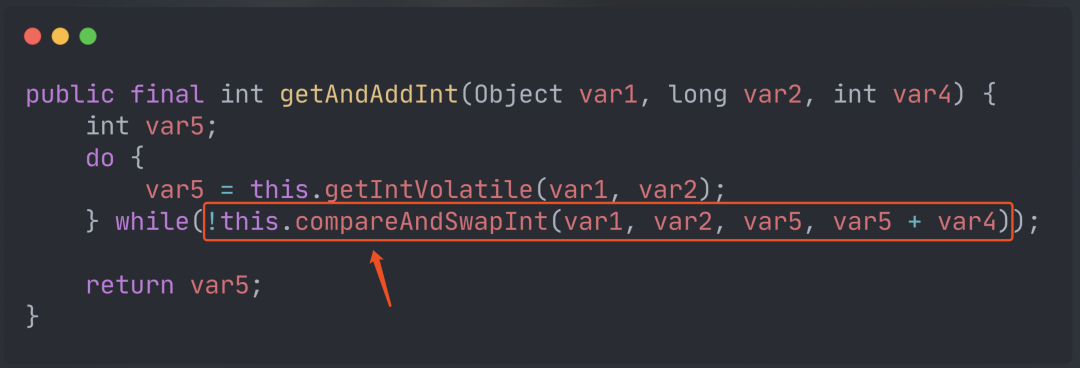前言
" JUC包下大量使用了CAS,工作和面试中也经常遇到CAS,包括说到乐观锁,也不可避免的想起CAS,那CAS究竟是什么? "
1.什么是CAS?
说到CAS,基本上都会想到乐观锁、AtomicInteger、Unsafe ...
当然也有可能啥也没想到!
不管你们怎么想, 我第一印象是乐观锁,毕竟做交易更新交易状态经常用到乐观锁,就自然想到这个SQL:
- update trans_order
- set order_status = 1
- where order_no = 'xxxxxxxxxxx' and order_status = 0;
其实就是 set和where里面都携带order_status。
那什么是CAS?
CAS就是Compare-and-Swap,即比较并替换,在并发算法时常用,并且在JUC(java.util.concurrent)包下很多类都使用了CAS。
非常常见的问题就是多线程操作i++问题。一般解决办法就是添加 synchronized 关键字修饰,当然也可以使用 AtomicInteger 代码举例如下:
- public class CasTest {
- private static final CountDownLatch LATCH = new CountDownLatch(10);
- private static int NUM_I = 0;
- private static volatile int NUM_J = 0;
- private static final AtomicInteger NUM_K = new AtomicInteger(0);
- public static void main(String[] args) throws InterruptedException {
- ExecutorService threadPool = Executors.newFixedThreadPool(10);
- for (int i = 0; i < 10; i++) {
- threadPool.execute(new Runnable() {
- public void run() {
- for (int j = 0; j < 10000; j++) {
- NUM_I++;
- NUM_J++;
- NUM_K.incrementAndGet();
- }
- LATCH.countDown();
- }
- });
- }
- LATCH.await();
- System.out.println("NUM_I = " + NUM_I);
- System.out.println("NUM_J = " + NUM_J);
- System.out.println("NUM_K = " + NUM_K.get());
- threadPool.shutdown();
- }
- }
下面就从AtomicInteger开始了解CAS。
2.源码分析
- public class AtomicInteger extends Number implements java.io.Serializable {
- private static final long serialVersionUID = 6214790243416807050L;
- // setup to use Unsafe.compareAndSwapInt for updates
- private static final Unsafe unsafe = Unsafe.getUnsafe();
- private static final long valueOffset;
- static {
- try {
- valueOffset = unsafe.objectFieldOffset
- (AtomicInteger.class.getDeclaredField("value"));
- } catch (Exception ex) { throw new Error(ex); }
- }
- private volatile int value;
- public final int incrementAndGet() {
- return unsafe.getAndAddInt(this, valueOffset, 1) + 1;
- }
- public final int decrementAndGet() {
- return unsafe.getAndAddInt(this, valueOffset, -1) - 1;
- }
- }
可以看出里面使用了Unsafe类下的getAndAddInt方法,Unsafe类很多方法是本地(native)方法,主要是硬件级别的原子操作。
- /**
- * @param var1 当前对象
- * @param var2 当前对象在内存偏移量,Unsafe可以根据内存偏移地址获取数据
- * @param var4 操作值
- * @return
- */
- public final int getAndAddInt(Object var1, long var2, int var4) {
- int var5;
- do {
- // 获取在var1在内存的值
- var5 = this.getIntVolatile(var1, var2);
- // 将var1赋值为var5+var4, 赋值时会判断var1是否为var5
- } while(!this.compareAndSwapInt(var1, var2, var5, var5 + var4));
- return var5;
- }
- // 原子操作
- public final native boolean compareAndSwapInt(Object var1, long var2, int var4, int var5);
至于 compareAndSwapInt 的分析就忽略了。
看完代码过程其实就是:
- 比较var1的值是否为var4,是的话将var1更新为var5。
- 如果不是的话就一直循环,直到var1是var4。
3.问题总结
- 这要是一直获取不到,岂不是一直循环。线程多的情况下,会自旋很长时间,导致浪费资源。
- 你更新了, 我又给你更新回去了,你也不知道。ABA问题!比如像这样,A想更新值为a,还未抢到资源,这时候B进行了更新,将对象更新为了b,然后又马上更新回了a, 这时候A是什么都不知道的。
以乐观锁举例:
- -- 0 -> 1
- update trans_order
- set order_status = 1
- where order_no = 'xxxxxxxxxxx' and order_status = 0;
- -- 1 -> 0
- update trans_order
- set order_status = 1
- where order_no = 'xxxxxxxxxxx' and order_status = 0;
- -- 0 -> 1
- update trans_order
- set order_status = 1
- where order_no = 'xxxxxxxxxxx' and order_status = 0;
解决办法可以添加version进行版本号控制。
- -- 0 -> 1
- update trans_order
- set order_status = 1
- where order_no = 'xxxxxxxxxxx' and order_status = 0 and version = 0;
- -- 1 -> 0
- update trans_order
- set order_status = 1
- where order_no = 'xxxxxxxxxxx' and order_status = 0 and version = 1;
- -- 0 -> 1
- update trans_order
- set order_status = 1
- where order_no = 'xxxxxxxxxxx' and order_status = 0 and version = 0;
代码中可以看 AtomicStampedReference 类:
- /**
- * 以原子方式设置该引用和标志给定的更新值的值,
- * 如果当前引用==预期的引用,并且当前标志==预期标志。
- *
- * @param expectedReference 预期引用
- * @param newReference 更新的值
- * @param expectedStamp 预期标志
- * @param newStamp 更新的标志
- * @return {@code true} if successful
- */
- public boolean compareAndSet(V expectedReference,
- V newReference,
- int expectedStamp,
- int newStamp) {
- Pair<V> current = pair;
- return
- expectedReference == current.reference &&
- expectedStamp == current.stamp &&
- ((newReference == current.reference &&
- newStamp == current.stamp) ||
- casPair(current, Pair.of(newReference, newStamp)));
- }
其实就是额外增加一个标志(stamp)来防止ABA的问题, 类似乐观锁的version。
本文转载自微信公众号「刘志航」,可以通过以下二维码关注。转载本文请联系刘志航公众号。






































